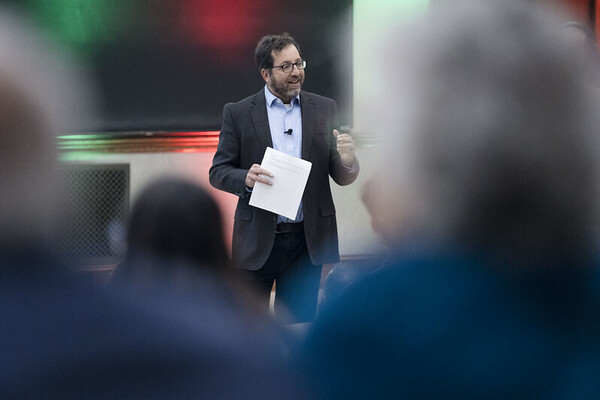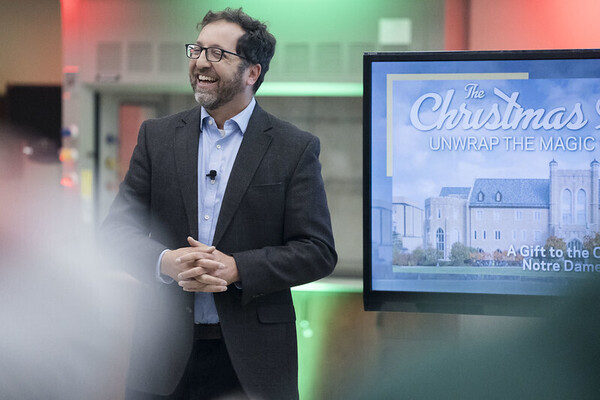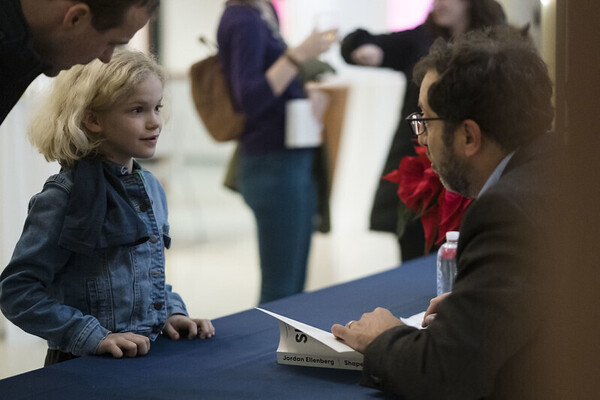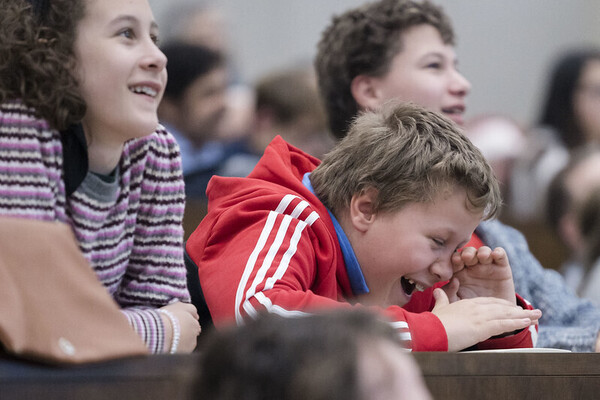

Jordan Ellenberg, the mathematician who presented the University of Notre Dame’s College of Science Christmas Lecture in December, doesn’t want to perpetuate the myth that all mathematicians develop their interest in numbers as precocious young children.
However, Ellenberg, the John D. MacArthur Professor of Mathematics at the University of Wisconsin at Madison, admits he mostly matches the stereotype.
“I was looking at my old high school diaries while doing some pandemic basement cleaning — the diaries are all about all the girls I liked, and math, and that’s basically my entire pie chart,” said Ellenberg, the author of New York Times bestsellers How Not to Be Wrong: The Power of Mathematical Thinking, and Shape: The Hidden Geometry of Information, Biology, Strategy, Democracy and Everything Else. “I’m a little embarrassed to admit that was actually my story, but that’s fine — that’s not everybody’s story, but for me it was.”
And while he didn’t share any old diary entries during the program in the Jordan Hall of Science, he did tell stories using examples from mathematics, and he sought plenty of audience participation.
In one segment of his talk, Ellenberg explained the concept of the Markov chain using text prediction as an example. He shared that in 1948, American mathematician Claude Shannon suggested that a Markov chain could create a model of the sequences of letters in English text. Shannon’s proposal has led to advancements not only in text prediction, but also in speech and handwriting recognition and spam filtering.
Ellenberg asked an audience member to select the first two letters in a random passage they found in a book, paper, magazine or other type of text, including from their phones. After someone in the audience chose the first two letters—Z and O—he then asked others to look for two more letters, but the first letter had to begin with an O. Punctuation and spaces were included.
The result was something that kind of, sort of, looks like words, causing the audience to erupt into laughter: ZORSE ABRKEYMEFOL.

Zoe Slott, 9, of South Bend, attended the talk with her parents John and Theresa Slott, as well as her sister, Miriam, 13, and brother, Teddy, 11. She enjoyed the talk and was excited that Ellenberg would sign one of his books for her.
“I like that in his book he mixes math facts with stories,” Zoe said, adding that she enjoys mathematics in general. “I like that in long division solving a bunch of smaller math problems gives you the answers to the division problem, and I like doing multiplication with fractions.”
Ellenberg’s text examples for the Markov chain hint at his other interest: writing. He even has a degree to prove his mettle with words: a master’s degree in fiction writing from Johns Hopkins University that he earned before earning his doctorate in mathematics from Harvard.
He completed it because he suspected that once he settled into a math career, he wouldn’t have time to write fiction, something he enjoyed in college. And while he’s become a successful mathematician in the fields of number theory and algebraic geometry, it’s the combination of math and writing skills that have allowed him to connect more easily with the public.
The topics Ellenberg tackles aren’t ones he feels the public needs to know; rather, they’re topics many people want to know more about. He believes most non-mathematicians want some skills with math to help them interpret events around them.

“There’s a demand for it; there have been editors and newspapers asking me to write about math because their readers want it,” said Ellenberg, who writes the “Do the Math” column for Slate. “People in publishing notice there’s a demand and a hunger to know more about math.”
He does, however, understand that many people are hesitant, and he suggests it’s because people innately dislike being wrong.
“That’s logically uncomfortable,” he said. “I try to impress upon my students that you can’t learn if you aren’t willing to be wrong, but math is a particularly stark form … there’s no way around it, because there are statements that are true and statements that are false.”
Discomfort aside, he said he’s found most people don’t dismiss math as “stupid.” Instead, their feelings are complicated, and they may feel that “I never really got it, and I feel bad about that, and I wish I had gotten it,” he said. “And that’s a very different feeling, right?”
When working on his mathematics research, Ellenberg understands that he won’t always understand or achieve the correct answer; almost everything mathematicians do will fail.
“And when you succeed in doing something, it’s pretty much always after some long period of not being able to do it, followed by a successful resolution,” he said.
Writing, however, is incremental. Most often, he knows what to do, but it’s an iterative process.
“You know, you lay the first coat down and it sucks. And then you lay the second coat down and you sort of go back and forth,” Ellenberg said. “And even when it’s on paper in the bookstore it still doesn’t really feel finished, and I think, ‘I could have done this better. I could have tightened up this writing more.’”
As such, his mathematics research is a bit removed from his teaching, and his writing is divorced from his mathematics. Though his research focuses on the fields of number theory and algebraic geometry (the parts of mathematics that address fundamental questions about algebraic equations and their solutions in whole numbers), his writing and speaking ability allows him to spend plenty of time talking with people about their purported fear of math.
His work has appeared in The New York Times, The Wall Street Journal, The Washington Post, Wired, The Believer, and The Boston Globe. His Wired feature story on compressed sensing appeared in the Best Writing on Mathematics 2011 anthology. His novel, The Grasshopper King, was a finalist for the 2004 New York Public Library Young Lions Fiction Award. His 2014 book How Not To Be Wrong was a New York Times and Sunday Times (London) bestseller and was one of Bill Gates’ top five summer books; it has been published in sixteen countries.
“When I do a public event, there’s always sort of a therapy aspect in it for people; people talk about their trauma, because maybe they have not encountered someone who can talk to them about how their geometry teacher was a jerk 30 years ago,” he said. “It’s finally their chance to talk about it.”
The Christmas Lecture series at Notre Dame aims to inspire in general audiences of different ages the wonder of scientific inquiry. It is modeled after the nearly 200-year-old Christmas Lecture series sponsored by The Royal Institution of Great Britain.
“We went to the Christmas Lecture at Notre Dame this year because we went last year and the kids wanted to go again. There’s something for everyone in these lectures: young kids, students, parents—anyone,” said John Slott. “My favorite part is watching the kids get excited and watching that excitement payoff. It’s a great opportunity to come together with the community in a classroom setting and come away with lessons both academic and relatable.”
Originally published by at science.nd.edu on December 19, 2022.